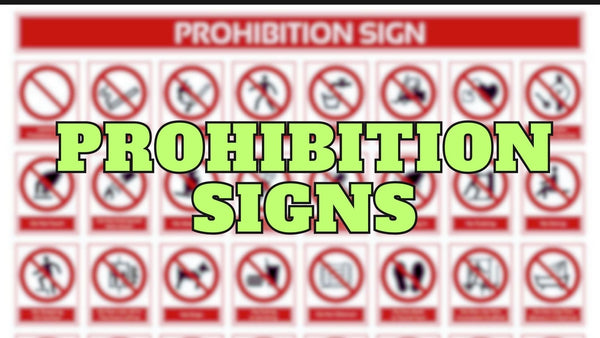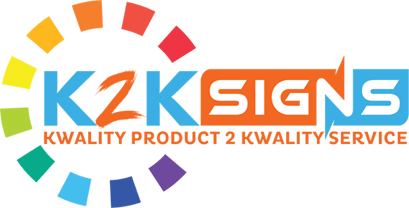Prohibition Signs & Their Meanings
Prohibition signs play a crucial role in conveying important messages by indicating explicitly prohibited actions. These signs employ easily recognisable symbols and universally understood visual cues to ensure clarity across language barriers.
In Australia, prohibition signs are employed in various settings to promote safety, prevent accidents, and enforce regulations. This blog post aims to overview prohibition signs, their significance, and where and when they are commonly used in Australia.

What are Prohibition Signs?
Prohibition signs are visual representations of rules or regulations that explicitly forbid specific activities, behaviours, or actions.
These signs are designed to convey concise and clear messages using symbols, colours, and text in an easily understandable manner to individuals of diverse backgrounds and languages.
Importance of Prohibition Signs
Prohibition signs are visual cues to prevent accidents, reduce risks, and ensure regulation compliance.
They help maintain order, protect individuals from harm, and create a safe environment in various public and private spaces.
- Safety Promotion: Prohibition signs play a vital role in promoting safety by clearly indicating actions or behaviours that are not allowed. They help prevent accidents, injuries, and potential hazards by communicating restrictions and limitations effectively.
- Risk Reduction: By explicitly prohibiting certain activities, prohibition signs help mitigate risks and minimise potential dangers. They provide essential guidance and reminders to individuals, ensuring they know and comply with necessary regulations or restrictions.
- Universal Understanding: Prohibition signs employ symbols and visual cues that are universally recognisable, transcending language barriers. They enable quick comprehension and understanding by people from diverse cultural and linguistic backgrounds, fostering clear communication and ensuring compliance regardless of language proficiency.
- Legal Compliance: Prohibition signs often reflect legal regulations and requirements. Displaying these signs helps establishments and organisations comply with local, state, or national laws. They serve as a visual reminder of legal obligations, helping individuals avoid legal consequences and promoting adherence to established norms.
- Order and Discipline: Prohibition signs maintain order and discipline in various environments. They establish boundaries and set expectations for behaviour by clearly outlining what is not permitted, ensuring a structured and controlled atmosphere. This is particularly important in public spaces, workplaces, and educational institutions.
- Hazard Prevention: Prohibition signs are crucial where certain actions or behaviours could pose immediate risks or hazards. By clearly stating "no smoking," "no open flames," or "no entry," they prevent potential accidents, fires, or exposure to dangerous substances, safeguarding individuals and property.
- Consistency and Standardization: Prohibition signs adhere to standardised designs and symbols, ensuring consistency across different locations and jurisdictions. This consistency allows individuals to quickly recognise and understand the message conveyed by the signs, regardless of location or familiarity with specific surroundings.
- Liability Reduction: Implementing prohibition signs can help reduce liability for establishments, organisations, or individuals. By clearly stating what is not allowed, these signs provide evidence of communicated rules and expectations, which can be crucial in legal proceedings or insurance claims related to accidents or incidents.
- Public Awareness and Education: Prohibition signs serve as educational tools, raising public awareness about specific rules, regulations, and safety practices. They help educate individuals about prohibited actions and behaviours, reinforcing responsible and respectful conduct in various settings.
- Enforcement Support: Prohibition signs support enforcement authorities, such as security personnel, law enforcement, or regulatory agencies. By clearly indicating prohibited actions, these signs empower authorities to take appropriate measures when violations occur, ensuring compliance and maintaining order.
Common Prohibition Signs in Australia
Below are some examples of prohibition signs commonly used across Australia:
- No Smoking Sign: This sign features a red circle with a lit cigarette inside, crossed out with a diagonal red line. It signifies that smoking is prohibited in the designated area.
- No Entry Sign: A red circle with a white horizontal bar indicates that entry into a particular area is strictly prohibited.
- No Photography Sign: This sign showcases a camera crossed out by a red diagonal line, indicating that photography is prohibited in the designated area.
- No Food or Drink Sign: This sign displays a pictogram of food and a drink container, crossed with a red line indicating that consuming food or drinks is prohibited.
- No Pets Allowed Sign: A graphic depiction of a dog with a red line across it signifies that pets are prohibited in the designated area.
- No Mobile Phones Sign: This sign features a mobile phone crossed out with a red line, indicating that the use of mobile phones is prohibited in the specified location.
- No Swimming Sign: This sign displays a figure of a person swimming with a red line across it, indicating that swimming is prohibited in the designated area.
- No Pedestrians Sign: A black figure of a person walking inside a red circle with a red line across it indicates that pedestrians are not allowed in that particular area.
- No Trespassing Sign: This sign showcases a person climbing a fence with a red line across it, indicating that trespassing is prohibited.
- No Bicycles Sign: A graphic representation of a bicycle with a red line across it signifies that cycling is prohibited in the specified location.
Usage of Prohibition Signs in Australia
Prohibition signs can be found throughout Australia to ensure safety and compliance with regulations.
They are commonly used in the following areas:
- Public Spaces: Prohibition signs are often seen in parks, recreational areas, and public buildings to enforce specific rules, such as no littering, skateboarding, or open fires.
- Workplaces: In workplaces, these signs are used to promote occupational health and safety. They indicate areas where personal protective equipment (PPE) must be worn, smoking is prohibited, or certain hazardous activities are forbidden.
- Roads and Traffic: Prohibition signs play a crucial role in traffic management, indicating actions that are not allowed, such as no U-turns, no parking, or no overtaking.
- Educational Institutions: Schools and educational institutions utilize prohibition signs to enforce regulations, such as no running in the corridors, no cell phone usage, or no unauthorized entry.
- Retail and Service Establishments: Prohibition signs can be found in retail stores, restaurants, and other service establishments to indicate rules such as no outside food, no pets allowed, or no photography.
Prohibition signs are indispensable visual tools that contribute to safety, order, and compliance with regulations in Australia.
These signs effectively communicate explicit prohibitions to individuals from various linguistic backgrounds by employing universally understood symbols, colors, and text.
Understanding and adhering to these signs is crucial for maintaining a secure and harmonious environment in public and private spaces across the country.

